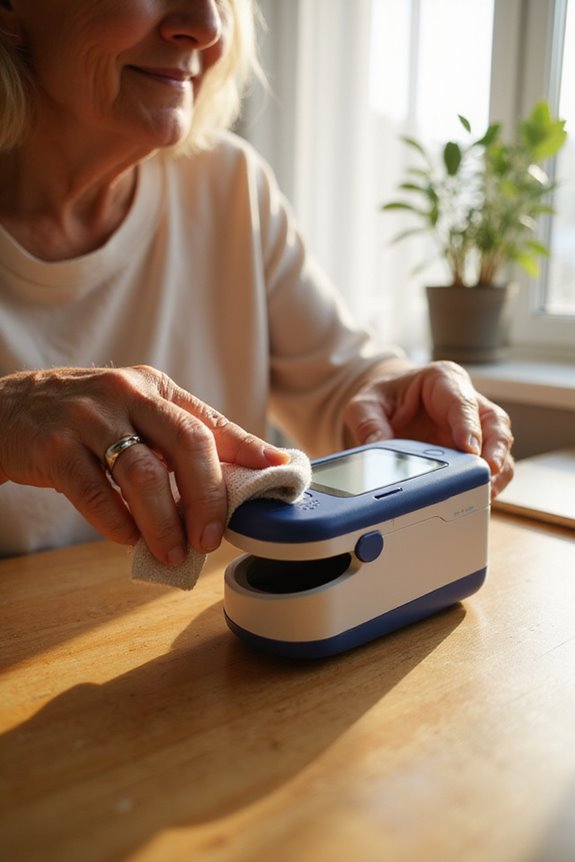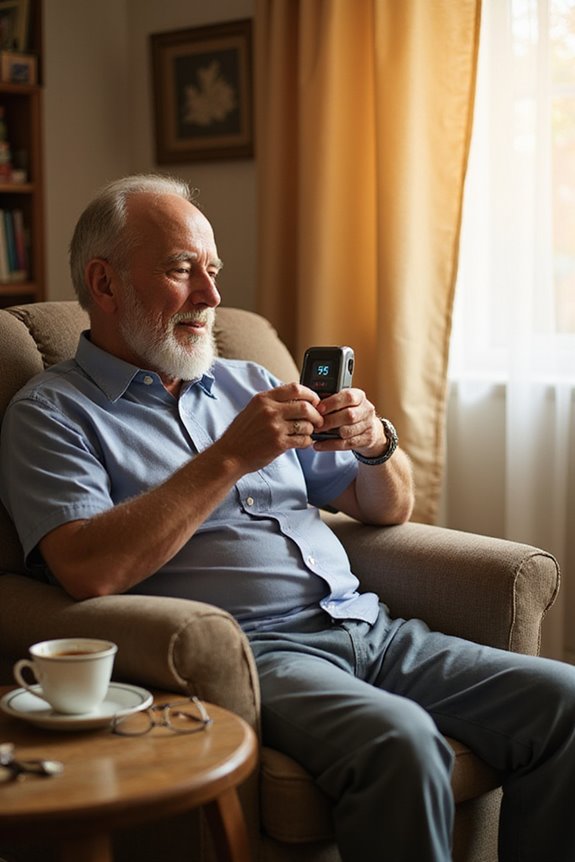Monitoring oxygen levels at home provides substantial benefits, including:
- Early Detection: Regular monitoring facilitates the recognition of respiratory decline and allows for timely therapeutic adjustments.
- Improved Outcomes: Patients often experience reduced severe episodes and lower mortality rates.
- Cost Efficiency: Remote monitoring correlates with a 46% decrease in emergency visits and reduced hospital stay duration.
- Quality of Life: It promotes patient autonomy and confidence in self-care.
Further insights are available on the integration and long-term advantages of consistent monitoring.
Key Takeaways
- Home oxygen monitoring allows for early detection of hypoxemia, enabling timely therapeutic adjustments and reducing the risk of severe complications.
- Continuous monitoring significantly decreases emergency department visits and hospital admissions, leading to lower healthcare costs.
- Patients gain autonomy in managing their health, improving their quality of life through proactive care and self-monitoring.
- Real-time data enhances clinical accuracy, facilitating personalized therapy adjustments and better disease management for chronic conditions.
- Home monitoring improves patient confidence and reduces the frequency of hospital visits, promoting a more convenient healthcare experience.
Early Detection and Intervention
Early detection of respiratory conditions is critical for effective intervention and management. Regular home oxygen monitoring facilitates symptom recognition, enabling patients to identify early signs of respiratory decline. This proactive approach empowers individuals, allowing them to seek timely medical care before conditions worsen.
Key aspects of early detection include:
- Real-time Monitoring: Continuous pulse oximetry provides immediate alerts regarding oxygen saturation levels.
- Prompt Clinical Assessment: Early identification of hypoxemia allows for timely therapeutic adjustments, reducing the risk of severe disease states.
- Reduced Emergency Admissions: Proactive management can lead to fewer unplanned hospital visits, optimizing healthcare resources. Additionally, maintaining measurement accuracy is essential for ensuring reliable readings that support effective monitoring.
Improved Clinical Outcomes
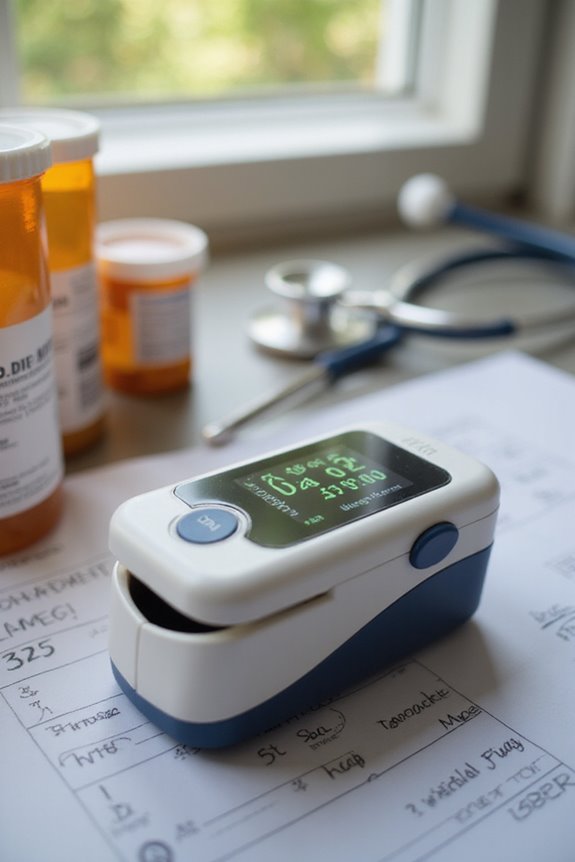
Monitoring oxygen levels at home has been shown to greatly improve clinical outcomes for patients with chronic respiratory and cardiovascular conditions.
- Home oxygen monitoring notably reduces the risk of severe adverse events, such as organ damage, by facilitating timely interventions through continuous pulse oximetry.
- Observational studies indicate that patients utilizing home monitoring experience fewer severe disease episodes and lower rates of emergency department visits.
- Additionally, structured protocols for oxygen therapy support safe discharge from hospitals, resulting in decreased readmission rates.
- Real-time data enhances clinical accuracy, allowing healthcare providers to make informed decisions and detect “silent hypoxia” early.
- Ultimately, consistent monitoring fosters better patient outcomes by preventing complications and aiding in disease management. Moreover, utilizing oxygen purity levels is essential for effective respiratory support and can significantly contribute to improved patient health.
Healthcare Utilization and Cost Reduction
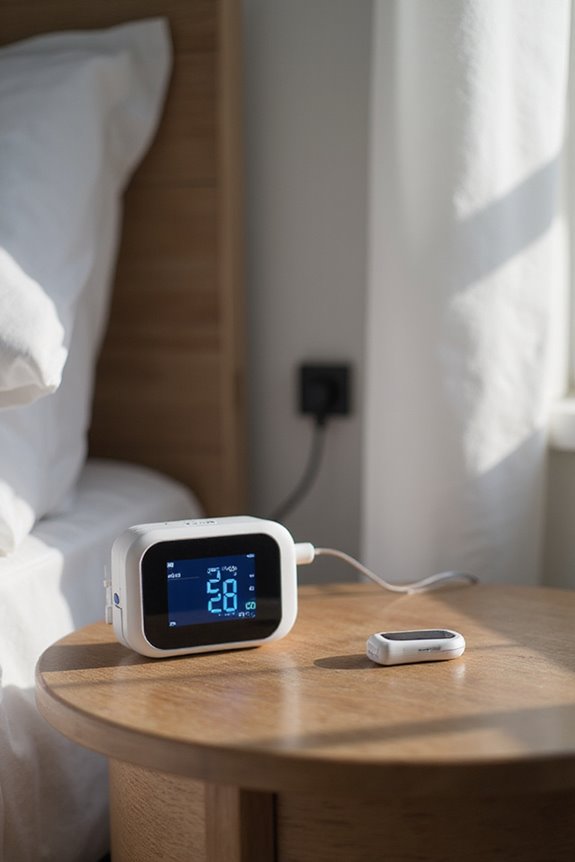
Healthcare utilization and cost reduction are greatly enhanced through effective home oxygen monitoring systems.
- Reduction in ED Visits and Readmissions: Patients using remote monitoring have 46% lower odds of emergency department visits, leading to significant healthcare savings.
- Shorter Hospital Stays: Enrollment in monitoring programs correlates with reduced hospital length of stay and lower 30-day mortality rates, optimizing healthcare resources.
- Cost-Effectiveness of Telemonitoring: Integration of internet-enabled devices allows continuous data transmission, streamlining patient supervision and reducing in-person visits.
- Earlier Detection: Timely identification of hypoxemia facilitates prompt medical responses, minimizing costly complications.
- System Efficiency: Remote monitoring improves hospital capacity, decreasing avoidable admissions and enhancing resource allocation. Additionally, the use of portable oxygen machines can further aid in effective home monitoring and management of oxygen levels.
Patient Convenience and Quality of Life
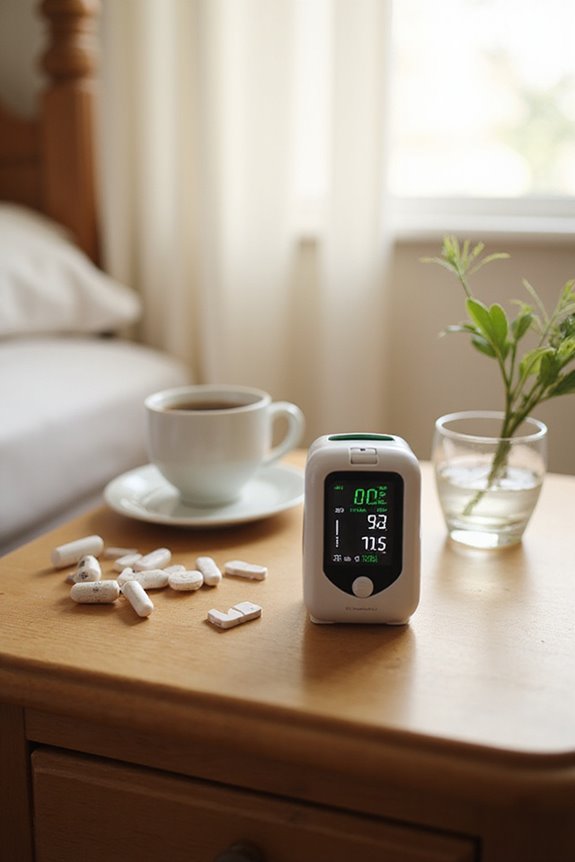
Patient convenience and quality of life are greatly enhanced through the implementation of home oxygen monitoring systems.
- Ease of Use: Home pulse oximeters are reported to be simple and safe, allowing for self-monitoring without frequent clinical visits.
- Accessibility: Consumer-grade devices and smartphone options have broadened availability, promoting home independence.
- Reduced Disruption: Monitoring at home minimizes the need for hospital visits, preserving patient comfort and routine.
- Active Engagement: Patients can manage their care proactively, fostering autonomy without significant lifestyle interruptions.
- Safety Perception: Continuous monitoring increases confidence, enabling early detection of hypoxia and timely interventions. Additionally, many users have reported improved quality of life through regular oxygen management at home.
Enhanced Disease Management for Chronic Conditions
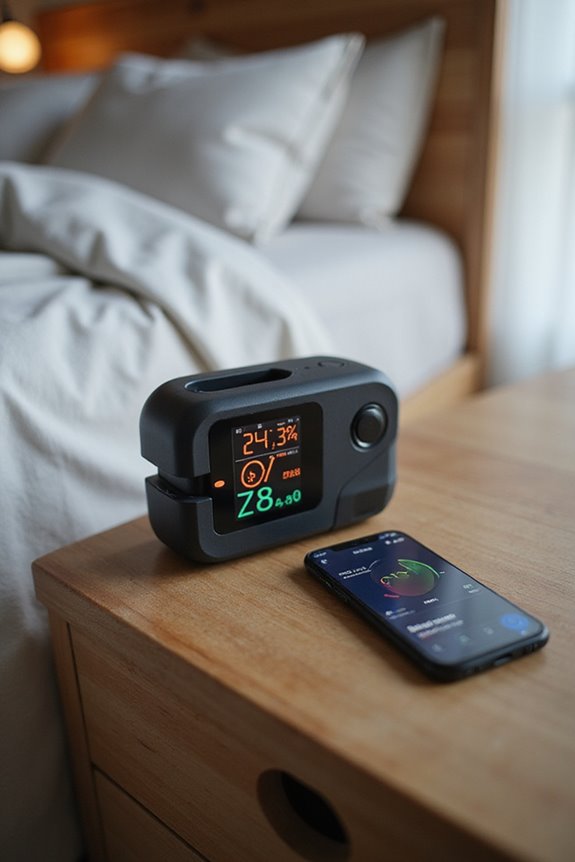
Enhanced disease management for chronic conditions is markedly advanced through the use of home oxygen monitoring systems. These systems facilitate early detection of hypoxemia, allowing for timely clinical interventions that improve patient outcomes. Key benefits include:
- Personalized Care: Tailored oxygen level thresholds enhance individual management strategies.
- Data Analytics: Continuous monitoring provides objective data, enabling clinicians to adjust therapies remotely, thereby optimizing treatment.
Moreover, studies indicate that home oxygen monitoring can reduce hospital admission rates by nearly 46%, leading to lower healthcare costs. Enhanced tracking correlates with significant mortality reductions, improving survival rates and overall quality of life. Through coordinated care and timely alerts, patients receive the support needed to manage chronic conditions effectively, fostering a sense of belonging within their healthcare journey. Additionally, the integration of oxygen therapy devices has shown to further support patients in achieving better health outcomes.
Technological Advances Facilitating Monitoring
Technological advancements in oxygen monitoring have greatly transformed the management of respiratory health at home.
IoT Innovations
- IoT-enabled oxygen concentrators capture time-series data, allowing healthcare providers remote access for analysis.
- These devices monitor patient variables, facilitating personalized therapy adjustments.
- Telemonitoring overcomes the limitations of infrequent outpatient visits, ensuring continuous compliance data.
Smartphone Engagement
- Dedicated smartphone applications enhance patient visibility into essential metrics such as SpO2 and device status.
- Immediate alerts inform patients of critical drops in oxygen saturation, promoting timely self-management.
- Real-time monitoring fosters patient empowerment and supports adherence to therapy plans.
Connectivity
– Seamless data sharing between devices and healthcare platforms enables proactive decision-making and personalized treatment strategies. Additionally, many models of portable oxygen concentrators are designed for quiet operation, which can enhance patient comfort during monitoring.
Remote Monitoring for Chronic Respiratory Diseases
Remote monitoring has emerged as a vital strategy in managing chronic respiratory diseases, particularly for conditions such as Chronic Obstructive Pulmonary Disease (COPD) and interstitial lung disease. This approach facilitates continuous physiological data collection, enabling early detection of deterioration and timely interventions.
Key benefits include:
- Improved disease management and reduced hospital admissions through early symptom recognition.
- Enhanced patient engagement via user-friendly tools, fostering self-management and adherence to treatment plans.
- Significant healthcare cost savings by minimizing emergency visits and hospitalizations.
Moreover, ensuring data privacy is essential for maintaining patient trust. Patient education initiatives support understanding of remote monitoring, empowering individuals to take an active role in their health management. Additionally, utilizing home oxygen concentrators can significantly improve the quality of life for patients through tailored oxygen delivery and support.
Integration With Home Oxygen Therapy
The integration of smart oxygen delivery systems with home oxygen therapy is revolutionizing patient care for individuals requiring supplemental oxygen. This oxygen integration offers continuous monitoring of respiratory parameters, including oxygen saturation and breathing patterns, enhancing home therapy efficiency.
Key benefits include:
- Remote Monitoring: Healthcare providers can assess therapy effectiveness and patient status in real-time.
- Early Detection: Integrated alerts facilitate timely clinical interventions, reducing complications.
- Convenience: Less frequent hospital visits contribute to improved patient comfort and potential cost savings.
- Personalized Adjustments: Data analytics enable tailored therapy based on individual needs. Additionally, these systems often utilize portable oxygen generators to ensure that patients have access to effective oxygen therapy at home.
Long-Term Benefits of Consistent Monitoring
Consistent monitoring of oxygen levels in home settings offers significant long-term advantages for patients requiring supplemental oxygen.
Reduction in Hospital Admissions****
- Patients experience 46% lower odds of hospital readmission with remote monitoring.
- Regular monitoring detects subtle changes, reducing the need for urgent medical attention.
Improvement in Clinical Outcomes****
- Home monitoring enhances symptom control, improving daily functioning and quality of life.
- Timely adjustments to care plans result from increased detection of oxygen desaturation.
Cost Savings Over Time
- Decreased hospital visits lead to reduced healthcare expenditures.
- Long-term monitoring can minimize overall medical expenses for chronic conditions.
Ongoing Disease Management****
- Continuous monitoring supports adherence to treatment plans through patient education and lifestyle modifications.
- Clinicians can make informed decisions based on accurate data, particularly regarding oxygen concentrators that provide consistent supplemental oxygen.
Frequently Asked Questions
What Types of Pulse Oximeters Are Recommended for Home Use?
In a world where health awareness reigns, various pulse oximeters, like finger clip models and handheld devices, cater to home users, offering options from budget-friendly to advanced medical-grade, ensuring accessibility and reliability for everyone.
How Often Should I Check My Oxygen Levels at Home?
The recommended daily frequency for checking oxygen levels varies based on individual health indicators. Those with severe conditions may require continuous monitoring, while others might check their levels one to four times daily, depending on symptoms.
Can Pets Affect the Accuracy of Pulse Oximeter Readings?
Pet interference can greatly impact pulse oximeter accuracy factors. Movement and environmental disturbances caused by pets may lead to measurement inconsistencies, highlighting the importance of a calm setting for reliable oxygen level assessments.
Are There Any Side Effects of Using Pulse Oximeters Frequently?
Frequent use of pulse oximeters may pose potential risks, including skin integrity issues, inaccurate readings influenced by various factors, and misinterpretation of physiological changes, emphasizing the importance of cautious monitoring and clinical correlation in assessments.
How Do I Know if My Pulse Oximeter Is Functioning Correctly?
To guarantee a pulse oximeter functions correctly, one should perform calibration checks and compare readings with clinical standards. Consistent reading accuracy can be verified through repeated measurements and consultation with manufacturer guidelines for ideal use.


